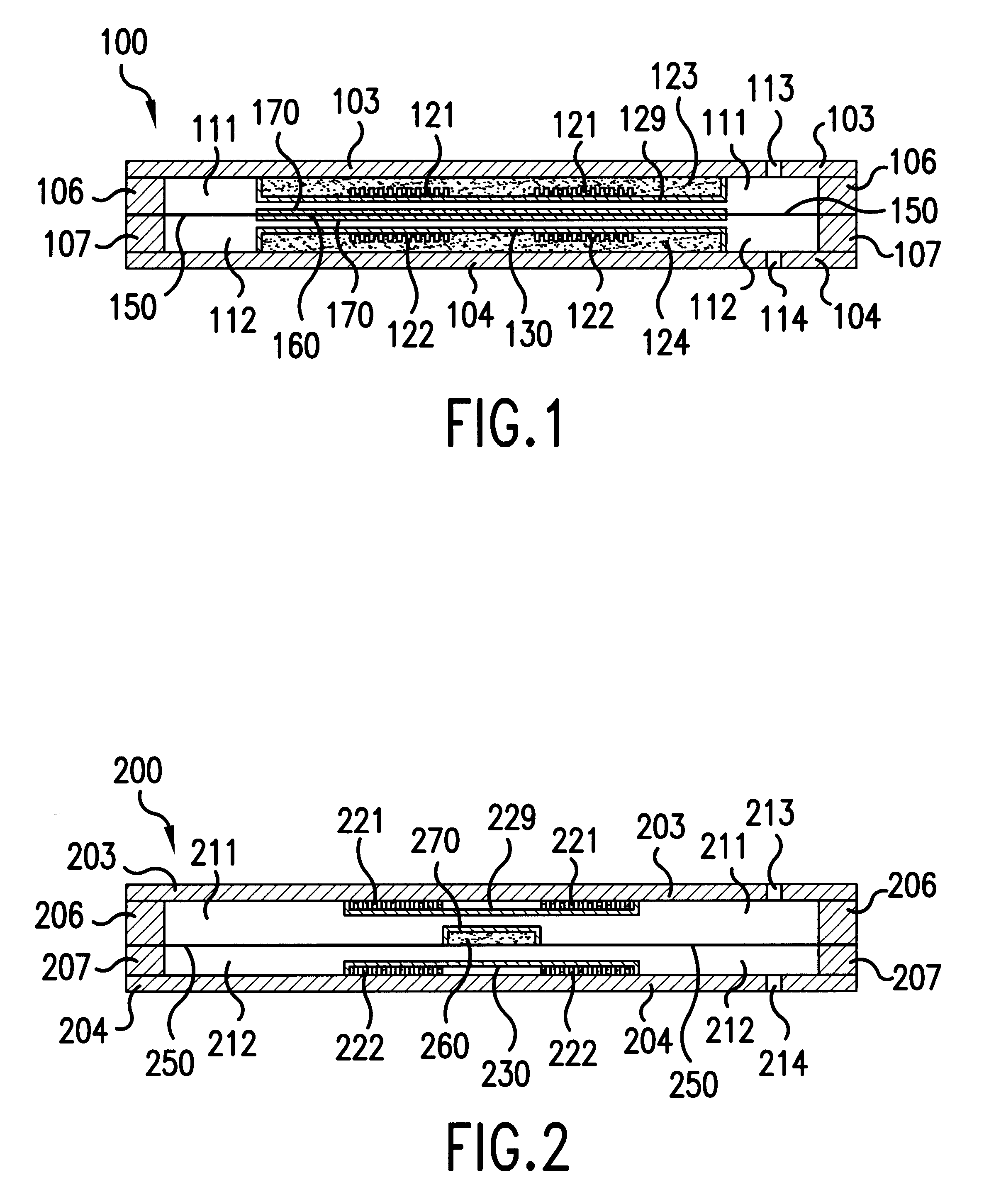The differential pressure transducers known to date are not suited for production with methods of planar technology. They have components with structures which are essentially three-dimensional and their production is structurally complex. In the pressure transducer as claimed in DE-A1-31 06 835 this applies especially to the compensation device which comprises an
electromagnet with a coil and a permanent magnetic armature, and the two have structurally complex three-dimensional structures. Conversely, the microengineering (and thus flat) coil of the differential pressure transducer according to the invention can be produced with means and methods of microengineering. In this way the possibility of economical, large-
series production of the differential pressure transducer as claimed in the invention is established. At the same time, the microengineering structure of the coil yields an outstanding possibility for
miniaturization not only of the coil itself, but the entire differential pressure transducer in accordance with the invention. By miniaturizing the pressure transducer the measurement errors which are caused by gravity can be greatly reduced, since the weight of the membrane decreases with the cube of the geometric dimensions. The reduction of the influence of gravity then allows the use of mechanically softer materials for producing the measurement membrane. In this way the choice of materials which can be used to produce the measurement membrane is greatly increased so that some chemically resistant materials can be used which, to date, had not been considered for the measurement membrane of known pressure transducers, because their low
mechanical strength under the influence of gravity and / or large differential pressures has / have caused overly large measurement errors.
In the differential pressure transducer as claimed in the invention, the feedback principle is used to measure the differential pressure. The
pressure difference to be measured between the two measurement spaces is applied to the membrane device. By means of the differential pressure either directly (i.e. without pressure transfer) or indirectly (i.e. after amplifying or weakening the pressure) a deflection force is produced which causes deflection of the measurement membrane of the membrane device from its
neutral position. A deflection sensor measures the deflection of the measurement membrane from its
neutral position, produces a deflection
signal which corresponds to this deflection, and supplies it to an
electrical switching device. The measurement membrane is coupled by magnetic means and an electromagnetic arrangement which comprises a current-conducting coil to the housing of the pressure transducer, i.e there is a magnetic force which is acting directly or indirectly between the measurement membrane and the housing. The switching device is electrically connected to the coil of the
electromagnet arrangement and produces a coil current such that the coil interacts by means of magnetic force with the magnetic means such that overall a force is exerted by the housing on the measurement membrane which essentially compensates for the deflection force acting on the measurement membrane in order to cancel the deflection of the measurement membrane from its neutral position. This is, in turn, measured by the deflection sensor (thus the
feedback loop is closed). As a measure for the differential pressure the strength of the coil current which is necessary to produce the magnetic compensation force is measured. This in contrast, for example, to the differential pressure transducers of the type described in WO 96 / 41141 where the deflection of the measurement membrane is used as a measure for the differential pressure. Thus, in the differential pressure transducer according to the invention, large deflections of the measurement membrane are avoided. This yields the
advantage that, in the pressure transducer of the invention, the measurement membrane need not meet high demands with respect to its mechanical properties in terms of to elasticity and / or
linearity. In particular, it is feasible to produce the measurement membrane of the invention using those materials which are mechanically soft and / or which have a small
linear elasticity range but, for example, are especially resistant to
corrosion.
Advantageously the measurement membrane is located in the measurement chamber which is defined by the housing such that the housing walls ensure effective overload protection against mechanical overloads of the measurement membrane. This is done by the distance which is perpendicular to the plane of the measurement membrane between the measurement membrane and the housing walls which border the measurement chamber being chosen to be as small ask possible. When the measurement membrane is overloaded as a result of the overly large differential pressure then the measurement membrane contacts one housing wall and is supported by it, thus preventing inelastic extension of the measurement membrane.
Advantageously the electromagnet arrangement is made and arranged essentially symmetrical with respect to a plane of symmetry which is defined by the measurement membrane, in order to reduce the formation of the asymmetrical temperature distributions which cause errors in
pressure measurement. These asymmetrical temperature distributions are often the cause of errors in pressure measurement by means of differential pressure transducers. With the symmetrical formation of the electromagnet arrangement at the same time position-dependent errors can be actively compensated, which even in the pressure transducer as claimed in the invention are still present as a result of the action of gravity on the measurement membrane when the latter is not positioned vertically.
According to one preferred embodiment of the invention the membrane device comprises simply a single membrane in the form of the measurement membrane, the membrane device being made and the measurement membrane being arranged such that one side of the measurement membrane is directly exposed to the first measurement pressure and the other side of the measurement membrane is directly exposed to the second measurement pressure. This embodiment of the invention enables simple construction of the membrane device with simply one single membrane.
The measurement membrane however can also be produced from a conventional membrane material and / or by means of suitable treatment of the surface it can be protected against
corrosion and / or other chemical reactions.
 Login to View More
Login to View More 


